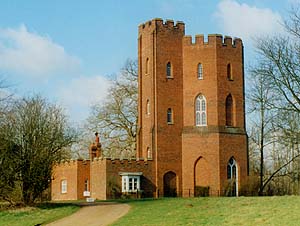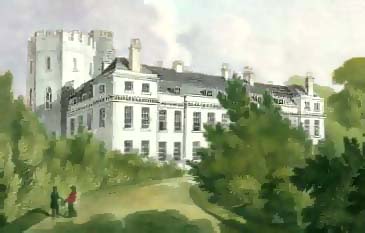|
|
|
 Cranbourne
Lodge Cranbourne
Lodge
Windsor, Berkshire
Sitting on the borders of Windsor and
Winkfield, the Cranbourne Tower is
possibly the most historic of the old Royal lodges
still to be seen in Windsor Great Park.
Cranbourne Chase was one of the many
divisions of Windsor Forest, created in the 13th century. The Keeper of the
Chase lived at the 'tower on the heath', later called Cranbourne Lodge. The
first tower was built in the 1480s, shortly before Henry VII took the
throne. William Staverton from Warfield
was then the Keeper but the new king threw him out as a supporter of his
enemies, the Yorkists. Henry VIII appointed his favourite, Richard
Weston, as Keeper and he undertook repairs to the tower in 1518.
Later the Stavertons were back in favour as keepers, followed by the Wards
of Hurst and Winkfield. The tower was once part of a much larger
and grander building first erected in the early 16th century. It was rebuilt
in 1665 and again in 1808
when the present tower was built.
However, it eventually fell into decay and was demolished in
1861.
 The
building has had many interesting associations over the years. The Surveyor
of the Navy, Sir Thomas
Aylesbury was the Keeper in the 1630s and his grandaughter, Anne
Hyde,
the mother of Queens Mary II and Anne, was born here in 1637. It remained
her childhood home until the age of twelve, when the Parliamentary victory
during the Civil War saw the lodge in the possession of Captain James
Whitelocke (eldest son of Sir Bulstrode
Whitelocke). After the Restoration, Anne Hyde's father, the 1st Earl of
Clarendon, had it as a retreat from public life. The diarist, Samuel Pepys,
visited many times when his superior, Sir George Carteret, Treasurer of
the Navy Board, was the Keeper in the 1660s. They would walk together in the Great Park
discussing Navy business. Once his guide got lost on the way there and Pepys
had to navigate by the moon. When he eventually arrived, the lodge was in
the middle of being rebuilt. There was no way in and he had to ascend a
ladder up to Carteret's bedroom and climb in at the window. John Evelyn
tells us of a great dinner given for the King there in 1674. Lord Ranelagh,
the Paymaster General of the Army, lived at the
lodge in the 1690s. He amassed a huge fortune under rather dubious
circumstances and spent much of it improving the park and gardens at
Cranbourne, as well as founding Ranelagh School in Winkfield and now Bracknell.
The 2nd Duke of St. Albans renovated the house in the 1750s before the Duke
of Cumberland moved in when Cumberland Lodge was being renovated at the
height of his patronage of Royal horse-racing. The famous racehorse,
Eclipse, was born in the field below the tower in 1764. He had a bowling
green there and grew pineapples in a specially built 'pinery'. Cumberland's nephew,
Edward, Duke of York, was afterwards in residence and he entertained the
King of Denmark there very grandly in 1768. Despite major repairs in the 1770s, by 1791 the place was almost falling down. So the lodge, including the tower, was substantially rebuilt, between 1804 and 1808, for George Villiers (a younger brother of the 6th Earl of Clarendon) who was George III's bailiff at his farms in the Great and Home Parks. He had to leave after over a quarter of a million pounds went missing from his office as Paymaster of the Marines. Most fascinating,
perhaps, is the story of Princess Charlotte who was locked up in the tower
in 1814 for having fallen in love with a minor Prussian prince who was
thought to be beneath her! The
building has had many interesting associations over the years. The Surveyor
of the Navy, Sir Thomas
Aylesbury was the Keeper in the 1630s and his grandaughter, Anne
Hyde,
the mother of Queens Mary II and Anne, was born here in 1637. It remained
her childhood home until the age of twelve, when the Parliamentary victory
during the Civil War saw the lodge in the possession of Captain James
Whitelocke (eldest son of Sir Bulstrode
Whitelocke). After the Restoration, Anne Hyde's father, the 1st Earl of
Clarendon, had it as a retreat from public life. The diarist, Samuel Pepys,
visited many times when his superior, Sir George Carteret, Treasurer of
the Navy Board, was the Keeper in the 1660s. They would walk together in the Great Park
discussing Navy business. Once his guide got lost on the way there and Pepys
had to navigate by the moon. When he eventually arrived, the lodge was in
the middle of being rebuilt. There was no way in and he had to ascend a
ladder up to Carteret's bedroom and climb in at the window. John Evelyn
tells us of a great dinner given for the King there in 1674. Lord Ranelagh,
the Paymaster General of the Army, lived at the
lodge in the 1690s. He amassed a huge fortune under rather dubious
circumstances and spent much of it improving the park and gardens at
Cranbourne, as well as founding Ranelagh School in Winkfield and now Bracknell.
The 2nd Duke of St. Albans renovated the house in the 1750s before the Duke
of Cumberland moved in when Cumberland Lodge was being renovated at the
height of his patronage of Royal horse-racing. The famous racehorse,
Eclipse, was born in the field below the tower in 1764. He had a bowling
green there and grew pineapples in a specially built 'pinery'. Cumberland's nephew,
Edward, Duke of York, was afterwards in residence and he entertained the
King of Denmark there very grandly in 1768. Despite major repairs in the 1770s, by 1791 the place was almost falling down. So the lodge, including the tower, was substantially rebuilt, between 1804 and 1808, for George Villiers (a younger brother of the 6th Earl of Clarendon) who was George III's bailiff at his farms in the Great and Home Parks. He had to leave after over a quarter of a million pounds went missing from his office as Paymaster of the Marines. Most fascinating,
perhaps, is the story of Princess Charlotte who was locked up in the tower
in 1814 for having fallen in love with a minor Prussian prince who was
thought to be beneath her!
The Cranbourne Tower is a private
residence belonging to the Crown. It can be viewed from the public footpath
alongside.
|
 |





 Cranbourne
Lodge
Cranbourne
Lodge The
building has had many interesting associations over the years. The Surveyor
of the Navy, Sir Thomas
Aylesbury was the Keeper in the 1630s and his grandaughter,
The
building has had many interesting associations over the years. The Surveyor
of the Navy, Sir Thomas
Aylesbury was the Keeper in the 1630s and his grandaughter,